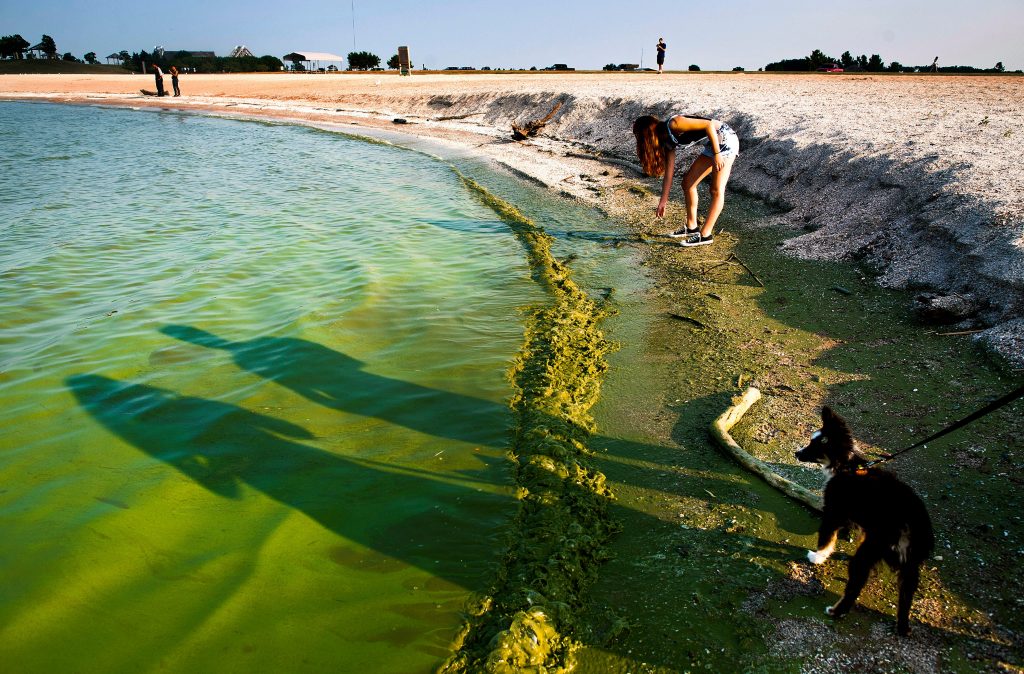- Lakes, rivers, and oceans may be unsafe to swim in due to toxins and microbes that can make people sick.
- Greenish, murky, or foul-smelling water may be infested with toxic algal blooms.
- Water near farms or sewage pipes are at risk of viral contamination, especially when there's runoff.
Health officials across the US have issued warnings about toxic algal blooms that can poison aquatic ecosystems and make bodies of water unsafe for swimmers.
Algae is just one of many microscopic organisms that can sicken humans and animals that come into contact with untreated water. Swimmers have fallen ill with diarrhea and vomiting after accidentally ingesting water contaminated by sewage, and a few have died suddenly due to brain-eating amoebas that thrive in warm waters.
Before you hit the beach this summer, consider these four signs that indicate water is not safe for swimming.
1. There's visible green scum, globs, or streaks on the surface
Algae and cyanobacteria (often called blue-green algae) can grow out of control in warm, slow-moving water that is rich in nutrients. Warming temperatures and sporadic rain storms have created the ideal conditions for algae to "bloom."
Not all algal blooms pose a threat to humans, but some species are known to produce toxins that can make people and animals sick. People have sought emergency care for algae-associated illness after swimming in, drinking, or accidentally inhaling water infested with harmful algal blooms.
According to the New York State Department of Health, algal blooms may appear green, blue-green, yellow, white, brown, purple, or red in color. Any splashes of color that look like spilled paint in the water, or suspicious foam or scum on the surface, may indicate that algae has bloomed.
Local health officials have warned residents to avoid all contact with water that appears discolored or murky in an abundance of caution. In the words of one Massachusetts emergency alert, "When in doubt, stay out!"
2. The water smells foul
Harmful algal blooms may emit foul-smelling gasses that have been compared to rotten eggs, septic tanks, and gasoline, according to a California water quality guide.
The human nose is especially sensitive to hydrogen sulfide, a naturally occurring gas that's released during decomposition. Air quality testing completed during harmful algal bloom events in Florida showed low levels of the gas that were not hazardous to human health, despite the offensive smell.
Algal blooms may also be associated with a fishy smell, as dense mats of algae can suffocate creatures living beneath the surface. In a guide to preventing algae-associated illness, the Centers for Disease Control and Prevention warned swimmers to avoid the water if dead fish or other animals have washed ashore.
3. There are pipes draining into the water
Funky-smelling water can also be attributed to human or animal waste that may be washed into swimming areas or deposited via sewage pipes.
Stomach bugs like norovirus and rotavirus typically come out one of two ends when people get sick with diarrhea and/or vomiting. Known as enteric viruses, they are shed in human stool and can spread via contaminated water.
Ideally, sewage is directed to a wastewater treatment plant to remove any pollutants before it's released into the environment. However, viruses and bacteria have been detected in water that passes official sanitation standards.
Heavy rainfall increases the risk that sewage spills over before it is properly treated, or that farm animal manure ends up in bodies of water by runoff, according to the Environmental Protection Agency.
4. Signs indicate that the swim area is closed
When in doubt, the CDC recommends heeding warnings put out by local health departments. If a sign indicates that a swimming area is closed, it's likely due to high levels of germs or toxins that make it unsafe.
For instance, the Brazos River Authority in Texas recently issued a warning to be aware of brain-eating amoebas that may be present in freshwater as the temperature rises. Infections with Naegleria fowleri are historically rare but have become more common in recent years, so it's more important than ever to take note of water quality warnings.

